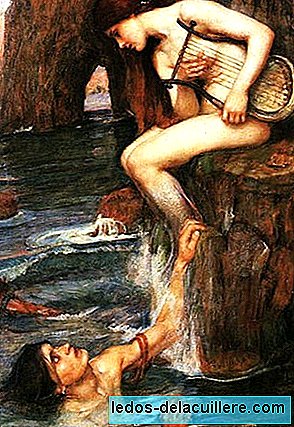
A few days ago we saw how classical music can evoke different animals, awakening the imagination and musical ear of the little ones. Continuing with the entries dedicated to the best classical music for children, today we are going to focus on another theme, the sea.
From a race between ships to a storm or the tranquility of a fishbowl, many landscapes and marine scenes await us. Very different music that invites you to immerse yourself in the depths and imagine stories of "The thousand and one nights."
Claude Debussy: the sea and the mermaids
Debussy is a mid-19th-century French composer who breaks the line of Brahms and Schubert's romanticism to find his own much more spontaneous language based on expressiveness. Debussy confessed to being passionate about the sea, and gathered his memories and images recorded in his memory to compose, "from the ocean," The Sea.
"La mer", "The sea" It is a work divided into three times, or "symphonic sketches" in the words of the composer, whose titles already evoke different situations that we can imagine to the sound of music:
- "De l'aube à midi sur la mer", "From dawn to noon over the sea" is the first movement, which opens with a gradual awakening of the sonority, from the softer sounds of the orchestra to its full sonority. From the darkness that precedes the sunrise we go through the day, we hear the sway of the waves, the sliding of the water in a movement that is like the sea, always the same although permanently changing.
- "Jeux de vagues", "Games of the waves" is more lively and the melodic fragments follow each other at different speeds, as suggesting the splashing of the waves. Debussy's biographer, Oscar Thompson, described this movement as a "world of diaphanous fantasy, strange visions and spectral voices, a mirage of vision and also a mirage of sound. In the vast stage of the sea there is a phantasmagoria close to trance, so evanescent and fugitive that it leaves behind only the vagueness of a dream. "
- "Dialogue du vent et de la mer", "Dialogue of wind and sea", is the final movement. In it Debussy uses some materials of the first movement plus some new fragments in an active seascape. The intensity of the music suggests a storm with the whipping of the wind over the waters or a fight between two antagonistic forces, especially with the sounds that sound loudly.
Debussy's next work dedicated to the sea in which we stop is "Sirens", which belongs to "Nocturnos". This composition evokes, using a chorus of female voices, the mythical episode of the sirens. The song of these women with fishtails represents in ancient mythology the power of mirage and the spell to separate man from his path; you will surely know this scene in its version of "Ulysses".
In "Sirens" we hear the hypnotics and suggestive songs of these creatures that pretend to attract sailors. The female choir is used as another instrument of the orchestra, since instead of pronouncing a text, it only uses the vowel "a". This is a very little used resource until then. Tell me if it doesn't hypnotize you a little too ...
Nicolai Rimsky-Korsakov: The thousand and one nights at sea
The next composer is the Russian Nicolai Rimsky-Korsakov, who with his symphonic poem "Sherezade" it makes us travel to the stories of "The thousand and one nights". I have had the opportunity to live the interpretation of this work live, and I can assure you that it is impressive how the viewer is transported to its history. We are in the fourth movement, entitled "Festival in Baghdad. The sea. The ship runs aground against a cliff surpassed by the Bronze Horseman."
Rimsky uses in this composition the technique of leitmotiv, which consists in associating a melody with an idea (a character, a feeling, a situation ...). In this fragment the melody that identifies the ship of Sinbad (He has already presented it in the first movement of the work) is used wrapped in a terrible storm. It is in the minute 8'10 seconds (from the interpretation we have here) when we can distinguish the strong gusts of wind and the great waves that crash against the boat.
"The Carnival of animals": the aquarium
Camille Saint-Saens, in his well-known "Carnival of animals", which we brought here in the previous selection of classical music for children, also dedicates a space to water and its marine inhabitants in "The Aquarium". We go from the storms and the waves to the calm of an aquarium, where the fish move slowly. The music seems to suggest the bubbles and the tranquility of the bottom of the fish tank with its leisurely and mysterious rhythm.
The aquatic sonorities are achieved through the use of instruments such as the celestial, the flute, the strings ... on a piano accompaniment. We seem to hear even the falling of a rock swaying towards the bottom of the aquarium.
Felix Mendelssohn and his "Calm Sea"
The German composer Felix Mendelssohn is the author of the overture "Meeresstille und glückliche fahrt", "Calm sea and prosperous journey". This composition is based on two short poems by the German Johann Wolfgang von Goethe, in which the reader finds the nostalgia of the traveler at his departure and also his hope when he arrives in the land of fortune.
Mendelssohn divides his work into two sections, each of which corresponds to a part of that title. The first, of tempo Slow, it corresponds to the calm sea, and is impregnated with serenity and balance, as if the ship glides effortlessly over a sea of flat and calm surface. A flute begins the transition to the second part, faster than the previous one, and corresponding to the prosperous journey. Full of optimism and hope, it seems to predict what awaits us upon arrival at the port. A small final coda returns us briefly and before finishing the atmosphere of the beginning.
As curiosity and rarity mention that also Beethoven He was inspired by the same text to write a short cantata, which is practically forgotten about concert programs.
The most terrifying of the sea
Finally, here I leave a nod to readers who, like me, declare themselves followers of John williams and that you will all recognize as soon as you hear the first chords. Fabulous to teach children that not everything is calm and kindness at the bottom of the sea. Come on, quite the opposite of "The Little Mermaid."
I hope this selection of the best classical music for children related to the sea you liked it and soon we will return with other fun melodies so that we learn and enjoy family music.












